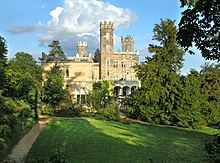Eckberg Castle
Eckberg Castle is one of the three Elbe castles and is located on the right slope of the Elbe in Dresden , about 3 kilometers up the Elbe from the city center. To the west of Eckberg Castle is the Lingner Castle and next to it the Albrechtsberg Castle .
History of Eckberg Castle
The history of Schloss Eckberg is closely linked to the development of the Elbe slope between Saloppe and Mordgrundbrücke . The slopes open to the south are said to have been used for viticulture since 1660. When more and more wealthy people settled in Dresden due to the increasing industrialization of Dresden, the Scot James Ogilvy, 7th Earl of Findlater , bought several vineyards around 1800, so that his vast property extended to the Elbe slope. After Ogilvy's early death in 1811, ownership of the extensive vineyard area changed several times. As early as 1832, Eckberg was released from Findlater's possession and repeatedly changed hands.
The Eckberg Castle was built from 1859 to 1861 on behalf of the wholesale merchant Johann Daniel Souchay, so that it was popularly called Villa Souchay at the time. Souchay used part of his large fortune for charitable foundations in Loschwitz and made great contributions to the development of this place. With the acquisition of the Eckberg vineyard in Loschwitz in 1859, Souchay decided to move his center of life to the Dresden Elbe Valley. On his behalf, the Semper student Christian Friedrich Arnold built the richly structured neo-Gothic palace on the site of the Klengelschen Landhaus built in 1675 on the Eckberg.
For the construction of Schloss Eckberg, Arnold used the Gothic style of construction that had been converted in the spirit of his time. Several country estates and landscape parks ( Tudor style ) are said to have served as a model. Johann Daniel Souchay entrusted the design of his 15 hectare landscape garden to the Prussian head gardener Hermann Sigismund Neumann , who had been brought to Dresden a few years earlier to lay out the gardens in the neighboring Albrechtsberg Palace and Villa Stockhausen (Lingnerschloss). At the same time as the castle, numerous outbuildings were built on Bautzner Strasse , including horse stables, a coach house, a gardener's house and a large neo-Gothic glass house.
Souchay also acquired the Mohrenhaus property in Niederlößnitz in 1861 and sold it on in 1866. The new owner took Souchay's Eckberg Castle as a model for his extensive renovations of the Mohrenhaus into a “stylish little castle”.
In 1883 the consul general Arthur Bruno Wunderlich acquired the property. After his death in 1909, his widow moved to the neighboring former Dinglingers winery . She rented the castle to the Austrian confectionery manufacturer Josef Weiser, whose wife Grethe Weiser later became famous as an actress. Around 1920 Mrs. Wunderlich leased the residence to the singer Tino Patiera.
When the industrialist Ottomar Heinsius von Mayenburg bought Eckberg Castle in 1925 , new life came to the castle and park. The interior of the upper floor was modernized according to the plans of his brother, the architect Georg Heinsius von Mayenburg , whereby the style character of the lower area was completely preserved. With the invention of toothpaste and aluminum tubes under the name " Chlorodont " and the establishment of the " Leo-Werke ", von Mayenburg had acquired wealth and was able to fulfill his lifelong dream. As a qualified botanist and passionate gardener, he mainly devoted himself to redesigning the park. Rock garden, tulip and crocus meadows are his creation. The owner of the castle earned a particularly high level of recognition in the city of Dresden because he made this splendor of flowers and the rose bloom available to the public every year. Tens of thousands admired the sea of flowers in this magnificent complex year after year. Von Mayenburg died in 1932 and his widow lived in the house until 1947.
After the expropriation of the von Mayenburg family in 1952, Eckberg Castle was used as a student dormitory, union school and for the manufacture of electronic parts. After a renovation from 1980–1985, the GDR youth tourist travel association operated Eckberg Castle as a hotel.
After the fall of the Wall, it returned to the possession of the von Mayenburg family, who sold it, so that in 1994 the property became the property of the ARGENTA group of companies in Munich. The palace complex and the park were completely renovated in 1997 and converted into a luxury hotel according to plans by the Italian interior designer Danilo Silvestrin . Around 35,000 guests visited the hotel each year. There are 55 employees.
literature
- Volker Helas : Villa architecture in Dresden . Taschen, Cologne 1991, pp. 82-84, ISBN 3-8228-9755-8 .
Web links
Individual evidence
- ↑ A long story on schloss-eckberg.de ( Memento from April 23, 2015 in the Internet Archive )
- ↑ Igel Tours Dresden (ed.): Dresden: New tour through history . Sutton Verlag, Erfurt 2011, ISBN 978-3-86680-782-2 , p. 133 ( limited preview in Google Book search).
- ^ Conversion to Eckberg Castle . In: Saxon newspaper . May 4, 2019 ( online [accessed May 4, 2019]).
Coordinates: 51 ° 3 '49.2 " N , 13 ° 47' 58.4" E



